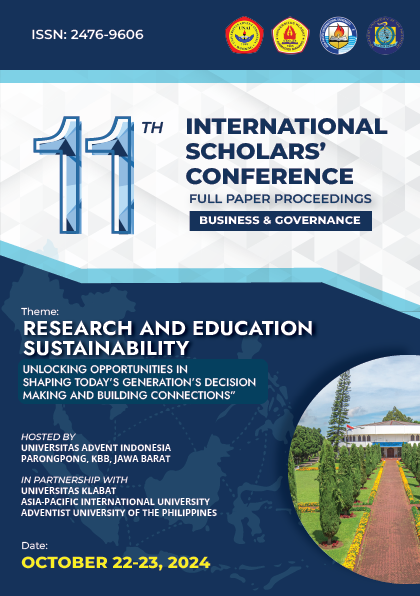Bridging Theory and Practice
Perceived Business Competencies and Institutional Attributes of BSBA Graduates
Keywords:
Business Competencies, Institutional Graduate Attributes, BSBA GraduatesAbstract
This study aimed to assess the perceived business competencies and institutional graduate attributes of Bachelor of Science in Business Administration (BSBA) graduates from 2001-2023. It explores the career paths of these graduates and examines their educational experiences related to their career success highlighting the effectiveness of the educational program in developing essential skills. A descriptive research design was employed, and data was gathered through survey questionnaires administered solely to the BSBA graduates from South Philippine Adventist College (SPAC). The data are from the responses of 128 graduates or 46% of the total graduates who have responded to the survey. The results shows that the overall mean score of perceived business competencies is high, with M =3.78 and SD=0.87. The graduates do have quite good knowledge and practice regarding the competency requirements of the business environment. Of all the skills that were measured, the competency to perform basic management functions had the highest rating: M = 4.04, SD = 0.88; thus, it showed the capacity of the graduates to plan, organize, direct, and control. BSBA graduates excel as creative and critical thinkers (M=3.95), service-driven citizens, M = 4.09; effective communicators, M = 4.03; transformative Christian values, M = 4.02; and a commitment to lifelong learning, M = 4.04. These findings confirm the program is successful in fostering the needed competencies and skills but point out specific areas that need additional growth. By adopting responsive academic programs that reflect real-world job market demands, institutions like SPAC can significantly improve the career prospects of their graduates, ensuring they remain competitive and relevant in today’s higher education landscape
Downloads
References
Barney, J. B., & Hesterly, W. S. (2015). Strategic management and competitive advantage: Concepts and cases (5th ed.). Pearson.
Benson, L., & Enström, R. (2017). Deliberate institutional differentiation through graduate attributes: Implementing professional skills at MacEwan School of Business. Journal of Management Development. https://doi.org/10.1108/JMD-08-2016-0148
Boekaerts, M. (1991). Subjective competence: Appraisals and self-assessments. Learning and Instruction, 1, 1–17.
Brown, P., & Hesketh, A. (2004). The mismanagement of talent: Employability and jobs in the knowledge economy. https://econpapers.repec.org/bookchap/oxpobooks/9780199269549
Commission on Higher Education [CHED]. (2017). Policies, standards, and guidelines for business programs. Retrieved from http://ched.gov.ph/wp-content/uploads/2017/07/CMO-No.39-s.-2017.pdf
De La Salle University. (2018, August 3). Principles of Lasallian education in the Philippines - De La Salle University. https://www.dlsu.edu.ph/inside/guiding-principles/education/
Fleetwood, D. (2023). Quantitative research: What it is, tips & examples. QuestionPro. https://www.questionpro.com/blog/quantitative-research/
Forage. (2023, October 11). What is creative thinking? Definition and examples. Career Services University of Pennsylvania. https://careerservices.upenn.edu/blog/2022/08/11/what-is-creative-thinking-definition-and-examples/#:~:text=Creative%20thinking%20is%20the%20ability,a%20wide%20variety%20of%20careers
Ipperciel, D., & ElAtia, S. (2014). Assessing graduate attributes: Building a criteria-based competency model. The International Journal of Higher Education, 3(3), 27. https://doi.org/10.5430/IJHE.V3N3P27
Jackson, D., & Wilton, N. (2017). Perceived employability among undergraduates and the importance of career self-management, work experience, and individual characteristics. Research Online. https://ro.ecu.edu.au/ecuworkspost2013/2790/
Jurše, M., & Tominc, P. (2008). Professional competences of graduates as a labour market mechanism for aligning business school curriculum reform with the Bologna Declaration principles. Management: Journal of Contemporary Management Issues.
Layaoen, M. P. F. (2024). Employers’ feedback on the expectations and performance of BSBA Marketing Management graduates of Mariano Marcos State University: A gap analysis. International Journal of Multidisciplinary Research and Analysis. https://doi.org/10.47191/ijmra/v7-i03-25
Pan, Y., & Lee, J. (2011). University life and employability. Higher Education, 61(4), 431-445. https://doi.org/10.1007/s10734-010-9360-5
Singh, J., & Del Bosque, I. R. (2008). Understanding corporate social responsibility and product perceptions in consumer markets: A cross-cultural evaluation. Journal of Business Ethics, 80(3), 597-611. https://doi.org/10.1007/s10551-007-9448-9
Staff, C. (2024, February 1). What is effective communication? Skills for work, school, and life. Coursera. https://www.coursera.org/articles/communication-effectiveness
Student Handbook Revised (2022). South Philippine Adventist College | Graduate Attributes (p. 5).
The University of Salford. (n.d.). Reflective lifelong learners | University of Salford. University of Salford. https://www.salford.ac.uk/careers/career-planning/employability-skills/reflective-lifelonglearners
Downloads
Published
How to Cite
Issue
Section
License
Copyright (c) 2024 11th International Scholars Conference

This work is licensed under a Creative Commons Attribution-ShareAlike 4.0 International License.
Copyright © 2024 ISC Committee.















